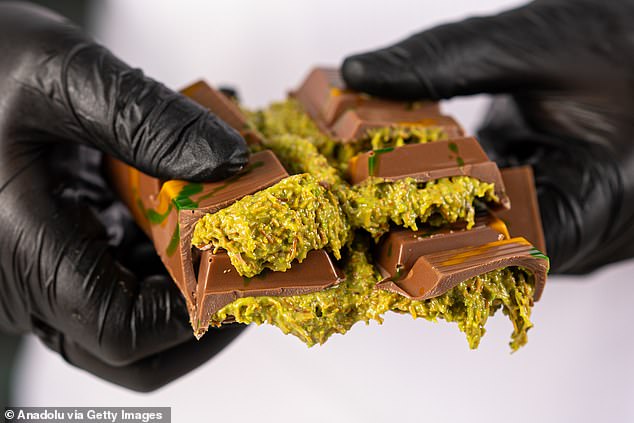From the famous feta pasta to the ‘horrifying’ Hot Pickle challenge, several quirky foods have stormed social media in recent years.
But one viral snack towers above the rest – Dubai chocolate.
Since TikTok got a taste of Dubai chocolate, appetite for the treat has skyrocketed – with influencers and foodies travelling thousands of miles and shelling out hundreds just to get their hands on the crunchy bar.
Within months of it launching, Dubai chocolate–flavoured products were being sold in supermarkets around the world.
So, why has this particular sweet treat proved so popular?
According to Professor Charles Spence, a professor of experimental psychology at Oxford University, its success is largely due to the ‘lurid’ green colour of the filling.
‘You have a powerful visual contrast: lurid green against brown chocolate,’ the scientist explained.
‘This makes it stand out in photographs and captures our attention since we are drawn to visually interesting objects (think of the Aperol spritz with its distinctive orange color).’

Since TikTok got a taste of Dubai chocolate, appetite for the treat has skyrocketed – with influencers and foodies travelling thousands of miles and shelling out hundreds just to get their hands on the crunchy bar
The viral chocolate first gained notoriety in 2024 when a Dubai–based chocolatier, inspired by her pregnancy cravings, began inventing filled chocolate bars to satisfy her sweet tooth.
Sarah Hamouda launched her brand Fix Dessert Chocolatier in 2021, later inventing the pistachio cream and filo–pastry filled pudding which went on to land global acclaim after TikTokker Maria Vehera posted a video sampling the treat in all its crunchy glory.
Maria’s original video triggered a global obsession, as thousands began posting ASMR videos sinking their teeth into the thick chocolate bars, leaving a flurry of salivating foodies desperate to sample it for themselves.
The viral bar is inspired by a Middle Eastern dessert called Knafeh and are filled with pistachio cream, tahini and Kataifi pastry – a pastry made from shredded filo dough.
On TikTok alone, billions have searched for the cocoa treat with hundreds sharing recipes and offering their thoughts on the viral bar.
And brands from across the globe have leapt on the trend, with the likes of Nestle, Lidl and Lindt having rushed to made their own versions.
Beyond the colour of its filling, Professor Spence says there are several other factors that have helped to fuel the Dubai chocolate’s success.
While it might sound strange, the scientist says that the fact that the chocolate bar is calorific might actually work in its favour.

Sarah Hamouda launched her brand Fix Dessert Chocolatier in 2021, later inventing the pistachio cream and filo–pastry filled pudding which went on to land global acclaim after TikTokker Maria Vehera posted a video sampling the treat in all its crunchy glory

According to Professor Charles Spence, a professor of experimental psychology at Oxford University , its success is largely due to the ‘lurid’ green colour of the filling
‘We are hard-wired to find the sight of energy-dense food exciting (no doubt an evolutionarily-selected trait in our distant ancestors),’ he explained.
‘This can also explain the surging popularity of other foods that combine visual stimulation with a high calorie count, such as rainbow- and unicorn-colored cakes.’
The chocolate’s exoticism is also a key element of its appeal, according to Professor Spence.
‘It comes from completely outside the bubble of many cultures,’ he said.
‘These days, people feel that they can gain “social kudos” by styling themselves as a “food discoverer,” and being the first to alert their network to a new food on the scene.
‘Bubble tea, for instance, originated in Taiwan in the 1980s, but has developed a global appeal during recent years, largely due to it being “discovered” and shared by social media influencers.’
Finally, unlike other treats, which aren’t particularly textural, the unique combination of crunchy and smooth translates well on camera.
‘The crunchy filling against the creamy chocolate also creates a strong textural contrast that you can feel in the mouth,’ Professor Spence said.
‘A key issue with showing food on social media is that the viewer can’t actually taste it.
‘This has led to increasingly extreme textures and flavors (for instance, spicy or sour) that provoke a facial (and, on occasion, fatal!) reaction in whichever influencer is showing off the product.’
Overall, the Dubai chocolate trend proves the power of social media.
‘Food trends on social media shouldn’t be dismissed as “millennial fads” but powerful forces that can shake global supply chains and agricultural sectors,’ Professor Spence concluded.
This article was originally published by a www.dailymail.co.uk . Read the Original article here. .

